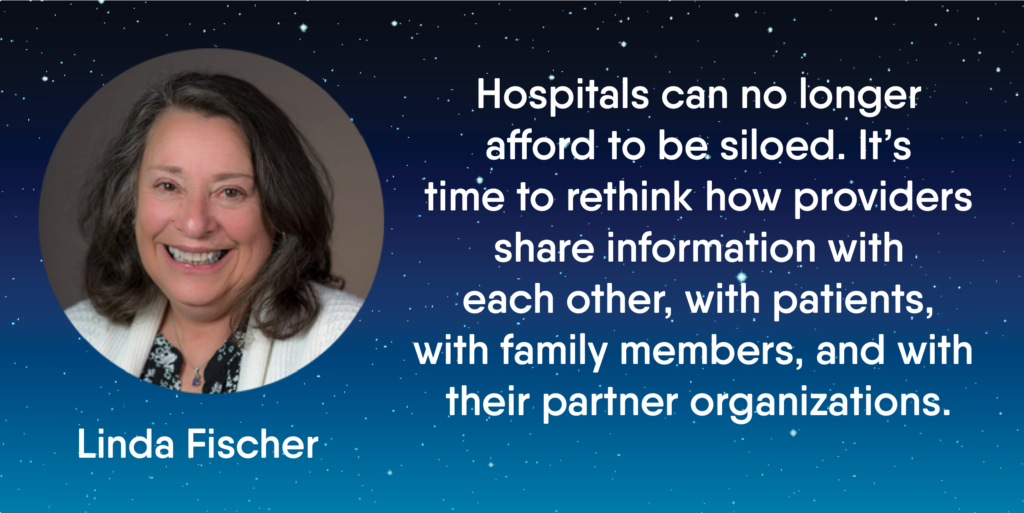Linda Fischer – Senior VP, Care Collaboration
The Healthiverse and Hospitals – The Importance of Care Collaboration During the Health Crisis
This blog is part of a series introducing the concept of the Healthiverse, explaining why it’s essential to eliminate the siloes between care team members, and exploring the benefits that a more united healthcare universe can deliver to different key stakeholders in the industry.
One of the most radical changes we’ve witnessed in the wake of COVID-19 is the rapid adoption of virtual care. Social distancing drove the need for and implementation of telehealth and care collaboration technologies almost overnight.
Before the pandemic, physicians didn’t encourage telehealth. They preferred in-person, on-site visits, and patients weren’t demanding virtual visits either. There was also a financial disincentive since CMS reimbursement for a remote patient encounter was significantly lower than an on-site visit.
Thankfully, as part of the quick response to COVID, CMS removed the barriers to telehealth visits and opened up the ability to treat a patient from any location, with reimbursement being equal to the on-site visit. That made telehealth a viable option for providers struggling to assess and treat patients at scale while maintaining social distancing.

The good news is it worked! Telehealth enabled an easy way for patients to see their doctor while avoiding potential contamination from other patients at the doctor’s office or hospital.
As a bonus, we’ve seen that virtual visits actually increase patient satisfaction.
The added benefit for patients is convenience. There’s less time required before and after a visit, no need to factor in transportation time back and forth to see the doctor, resulting in a better care experience.
Patients love it and want it to remain a normal method of treatment. It’s like the saying goes, “You don’t know what you are missing if you’ve never had it,” and that certainly applies to telehealth.
The Power of Virtual Care and Remote Collaboration
Telehealth is a good start, but video conferencing is only part of the equation when it comes to supporting remote healthcare. Patients and providers are already demanding more capabilities to be able to share additional types of information in different formats (like images, files, forms, or and text messages). This is where care collaboration technology comes in.
Care collaboration platforms bundle telehealth, secure messaging, file sharing, e-forms integration, automated alerts, and more into one unified HIPAA-compliant application so it’s easy for everyone involved in a patient’s care to connect and share information.
This is critical as the health crisis continues and as more and more patients take advantage of virtual care and hospitals become increasingly reliant on it as an expected part of the clinical experience.
But these technologies also have an important role in creating efficiencies that can strengthen the hospital’s bottom line. For example, many organizations employ case managers who physically visit patients at home. This is often cost-prohibitive and inefficient, not to mention unsafe during a pandemic.
Using telehealth and care collaboration technology, case managers no longer have to travel back and forth from patients’ homes. Case managers can connect with patients remotely and get a quick update on their health through a short video session or a secure text chat.
That will allow case managers to be more productive, allowing resources to be redistributed to other expenses (like much needed PPE) while improving quality and helping prevent readmissions, both of which impact hospital reimbursements.
Another example is post-surgical follow-up appointments, which are traditionally conducted in person. Patients find coming to the facility for check-ups to be inconvenient (and risky in light of COVID). Meanwhile, clinicians want a quicker way to follow up with patients so they can allocate more time to valuable treatment and procedures.
With these technologies bundled together, doctors can communicate directly with patients and choose the best method of outreach, contributing to better post-care follow-up. Physicians can use secure HD video to assess a patient’s recovery and wound care, send electronic versions of post-treatment surveys, or simply send a quick text to ensure that the patient is following discharge instructions.
By using telehealth and care collaboration, less time is needed for follow-up appointments and more time can be dedicated to elective surgeries and procedures. That means more revenue for hospitals that have been financially strained by the battle against COVID.
Plus, patients feel more connected to their doctors, they’re less likely to be readmitted, and more likely to have a positive healthcare outcome.
Unite the Healthiverse
These are just a few examples of how care collaboration can help improve clinical workflows. But they’re not limited to patient-to-provider interactions.
These same tools can be used to eliminate the gaps between the care team, between providers and family members or caregivers, or even between traditionally siloed organizations.
Prior to joining DrFirst, I spent 21 years as a VP and CIO for Huntington Hospital in Long Island, NY. During the time I was there, I—much like thousands of other hospital CIOs in the country—spent hundreds of thousands of dollars installing an electronic medical record (EMR) solution. Unfortunately, most of us discovered after the fact that these investments only created a new set of problems.
We were all implementing different systems, which resulted in disparate solutions being utilized and no simple way to share healthcare data. There was no data or record of what happened to patients after they left the hospital building. In fact, even organizations and facilities within the same hospital system struggled to coordinate and share patient information.
These information gaps negatively impact the hospital’s bottom line, affect patient outcomes, and prevent organizations from fully embracing new approaches to delivering quality healthcare.
Just imagine how much better care would be if we could unlock new ways to collaborate and communicate across the entire healthcare ecosystem.
Think about how we can improve wellness, financial, and quality outcomes if we can just be more effective in connecting everyone who has a stake in a patient’s care.
At DrFirst, that’s our mission—to unite what we call “the Healthiverse.”
Hospitals can no longer afford to be siloed. It’s time to rethink how providers share information with each other, with patients, with family members, and with their partner organizations.
Learn more about the Healthiverse and how new technologies make providers and patients more collaborative, informed, and connected.
The “Healthiverse” is a term coined by DrFirst to describe our vision of a united healthcare universe where everyone is connected in real-time to each other and to the information they need, so patients get the best care.


















